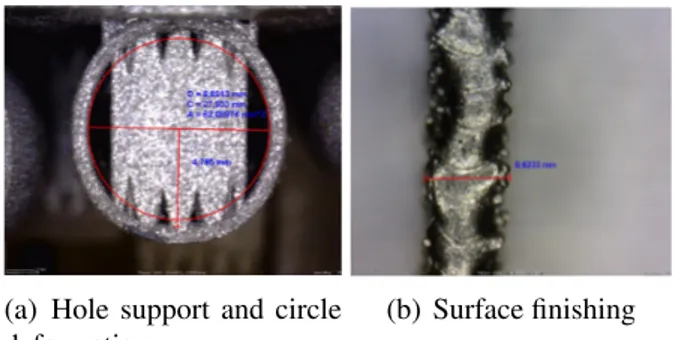Deterministic Manufacturing Constraints for Optimal Distribution in the
Case of Additive Manufacturing
Simon Bauduin†,Maxime Collet†, Didier Garray‡,Denis Gravet‡,Pierre Duysinx†
†Aerospace and Mechanical engineering department
University of Lige
Chemin des Chevreuils, 1, B52, Lige, Belgium S.Bauduin,Maxime.Collet,P.Duysinx@ulg.ac.be
‡
Sirris Driving industry by technology Lige Science Park
Rue du Bois Saint-Jean, 12, Seraing, Belgium didier.garray,denis.gravet@sirris.be
Key words: Topology optimization, manufacturing constraints, additive manufacturing ABSTRACT
Topology optimization is widely used as a design tool for advanced application mechanical, aerospace and automotive industries. This technique offers an optimal distribution of a pre-determined amount of material in a given design space [1]. In the last years a lot of efforts has been put into the development of high performance methods such as homogenization [2], SIMP [1] or BESO [4]. However as the state of art in manufacturing undergoes evolution a coupling between both is needed.
Additive manufacturing has numerous advantages that fits the characteristics of topology op-timized designs [3]. It can manufacture highly complex design without high cost increase and furthermore continuous density material of the SIMP method could be manufacture by lattice structures [3]. With all the opportunities given by the additive manufacturing the urge to bind the last one to topology optimization is heavily required.
However specific constraints related to manufacturing issues have to be taken into account such as the need of support material to ensure a good heat evacuation as well as to hold up overhang section as shown in Fig. 1a. Moreover constraints depending on the manufacturing limitations (LBM, EBM, 3D printing) also must be taken into account such as the minimum size of walls, maximum bridge distance, orientation of the manufactured part, anisotropic be-havior of the material, no closed cavities or the surface finishing (Fig. 1b) all those appear when additive manufacturing is used [6]. Some researches have been done to include these new constraints in the optimization formulation. For instance Leary and al. [7] create designs that do not need support structures or Lemaire [5] create a structure without closed cavities. Nevertheless we are far from an optimization formulation that accounts for all of these con-straints.
In this work we implement in the optimization formulation some of the manufacturing con-straints. Our work is based on the MATLAB optimization code of O. Sigmund [8] and in-cludes some of the limitations caused by the manufacturing method. Those limitations are
(a) Hole support and circle deformation
(b) Surface finishing
Figure 1: Exemple
the minimum diameters of holes or channels, the tilt angles of constructions, the definition of cavities, the precision of construction of prismatic volume or the precision and quality of the manufactured part. Thanks to Sirris those constraints were quantified for two major additive manufacturing that are LBM and EBM and are implemented in our topopt MATLAB code. Acknowledgement. The first author Simon Bauduin would like to acknowledge the FRED interred 4a programme for its support.
References
[1] Bendsφe M., Sigmund O., Topology optimizationtheory, methods and applications. Springer Verlag, New-York 2003
[2] Bendsφe M., Kikuchi N., Generating optimal topologies in structural design using a homogeneization method ,Comput Methods Appl Mech Eng 71:197-224,1988
[3] Bracket D., Ashcroft I, Hague R., Topology Optimization for Additive Manufacturing, Wolfson School of Mechanical and Manufacturing Engineering, Loughborough Univer-sity,2010
[4] Huang X., Xie Y. M., Evolutionary topology optimization of continuum structures: Meth-ods and Applications, John Wiley and Sons, West Susses, 2010
[5] Lemaire E., Topology optimization of Electrostatic MEMS Including Stability Con-straints., PhD thesis, , University of Lige, 2013
[6] Meunier B., Perspectives de dveloppement pour le couplage optimisation topologique et fabrication additive de composants mcaniques., Master thesis, University of Lige, , 2014 [7] Martin Leary, Luigi Merli, Federico Torti, Maciej Mazur, Milan Brandt, Optimal topol-ogy for additive manufacture: A method for enabling additive manufacture of support-free optimal structures, Materials and Design, 63:678-690 , 2014
[8] Sigmund O., A 99 line topology optimization code written in Matlab, Struct Multidisc Optim, 21:120-127, Springer Verlag, 2001
